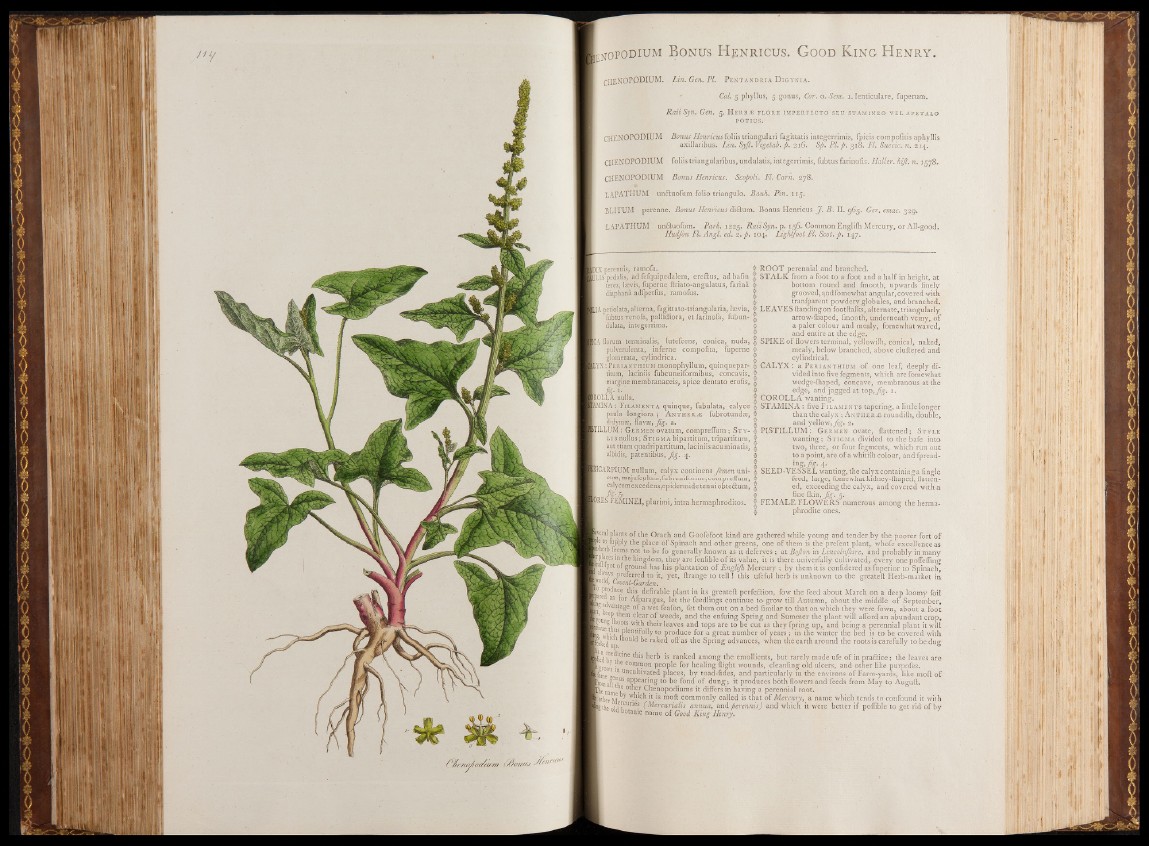
J e n o p o d iu m B o n u s H e n r i c u s . G o o d K in g H e n r y .
CHENOPPDIUM. Lin. Gen. Pl. Pen tandria Dlg yn ia .
Cal. 5 phyllus, 5 gonus, Cor. o. Sem. 1. lenticulare, fuperum.
RaiiSyn. Gen. g. Herb.e flore imperfegto seu stamineo ve l ape talo
pot ius.
CHENOPODIUM Bonus Henricus foliis triangulari fagittatis integerrimis, fpieis compofitis aphyllis
axillaribus. Lin. Syfi. Vegetab. p. 21-6. Sp. Pl. p. 318. FL Suecic.n. 214.
CHENOPODIUM foliis triangülaribus, undulatis, intégerrimis, fubtus farinofis. Haller, hiß. n. 1578.
CHENOPODIUM Bonus Henricus. Scopoli. Fl. Carn. 278.
LAPATHUM un&uofum folio triangulo. Bauh. Pin. 115.
BLITUM perenne. Bonus Henricus diftum. Bonus Henricus J . B. II. 965. Ger. emac. 329.
LAPATHUM un&uofum. Park. 1225. RaiiSyn. p. 156. Common Englifh Mercury, or All-good.
Hudfon FL Angl. ed. 2. p. 104. Lightfoot EL Scot. p . 147.
t)IX perennis, iramofa.
IJLIS pedalis, ad fefquipedalem, ereftus, ad bafin i
teres, laevis, fuperne ftriato-angulatus, farina •
diaphana adfperfus, ramofus.
llA petiblata, alterna, fagittato-triangularia, laevia,
fubtus venofa, pallidiora, et farinofa, fubun-
dulata, integerrima.
_J)A florum terminalis, lutefcens, conica, nuda,
pulverulenta, inferne compofita, fuperne
glomerata, cylindrica.
IYX:.Perianthium monophyllum, quinquepar-
titum, laciniis fubcuneiformibus, concavis,
margine membranaceis, apice dentato erofis,
„ 1 M 1-', '
lOLLA nulla.
«MINA: Filament a quinque, fub.ulata, calyce
paulo longiora; A n th e r s fubrotundae,
didymas, flavse, Jig. 2.
TILLUM: Germen ovatum, compreflum ; S t y lus
nullus; Stigma bipartitum, tripartitum,
aut etiam quadripartitum, laciniis acuminatis,
albidis, patentibus, Jig. 4.
JICARPIUM nullum, calyx continent femen uni-
cum, majufculum, fubreniforme, compreflum,
calycem excedens,epidermide tehui obte&um,
®RES FEMINEI, plurimi, intra hermaphrodites^
ROOT perennial and branched.
S T A LK from a foot to a foot and a half in height, at
bottom round and fmootb, upwards finely
grooved, qnd fomewhat angular, covered with
tranfparent powdery globules, and branched.
LEAVES handing on footftalks, alternate, triangularly
arrow-Ihaped, fmooth, underneath veiny, o f
a paler colour and mealy, fomewhat waved,
and entire at the edge.
SPIKE of flowers terminal, yellowilh, conical, naked,
mealy, below branched, above cluftered and
cylindrical.
C A L YX : a Perianthium of one leaf, deeply divided
into five fegments, which are fomewhat
wedge-fhaped, concave, membranous at the
edge* and jagged at top, Jig. 1.
‘ COROLLA wanting.
i STAMINA : five Filaments tapering, a little longer
than the calyx ; A nther.ce roundilh, double,
and yellow, Jig. 2. \
PIST ILLUM : G ermen ovate, flattened; Sty le
wanting; S tigma divided to the bafe into
two, three, or four fegments, which run out
> to a point, are of a whitilh colour, and fpread-
; •; -
: SEED-VESSEL wanting, the calyxcontaininga Angle
feed, large, fomewhat kidney-fhaped, flattened,
exceeding the calyx, and Covered with a
fine fkin, fig. g.-
■ FEMALE FLOWERS numerous among the herma-
, . phrodite ones.
feral plants of the Orach and Goofefoot kind are gathered while young and tender by the poorer fort of
I|e to fupply the place of Spinach and other greens, one of them is the' prefent plant, whofe excellence as
B-nerb feems no't to be fo generally known as it deferves ; at Bofion in LincolnJhire, and probably in many
»places in the kingdom, they are fenfible of its value, it is there, univerfally cultivated, every one poflefling
■ a| P°t °f ground has his plantation of Engli/h Mercury ; by them it is confideredas fuperior to Spinach,
Ma ways preferred to it, yet, ftrange to tell! this ufeful herb is unknown to the greateft Herb-market in
frorld, Covent-Garden,
» produce this defirable plant in its greateft perfection, fow the feed about March on a deep Ioomy foil
r e , as *or Afparagus, let the feedlings continue to grow till Autumn, about the middle of September,
O ? va’ntage of a wet feafon, fet them out on a bed fimilar to that on which they were fown, about a foot
Jy oi^ n 1 le m C!e a r weeds, and the enfuing Spring and Summer the plant will afford an abundant crop,
fjnunSj ot® with their leaves and tops are to be cut as they fpring up, and being a perennial plant it will
L ^ .^ flen t ifu ^ to produce for a great number of years ; in the winter the bed is to be covered with
^forked up ' ^ raHe^ | f l as the Spring advances', when the earth around the roots is carefully to be dug
jied K tH*16 ^ *s ranked among the emollients, but rarely made ufe of in pra&ice; the leaves are
common people for healing flight .wounds, cleanfing old ulcers, and other like purpofes.
(ame * 10 Uncu^^vat'ed places, by road-fioes, .and particularly in the environs of Farm-yards, like moft of
l r°raafhbUS afPear*n§ t0 be fond of dung; it produces both flowers and feeds from May to Auguft.
j * nam 0 _,r Ch’enopodiums it differs in having a perennial root.
I'other M ? If m°ft commonly called is that of Mercury, a name which tends to confound it with
Ig iLe ol^e[,CUne? r Mercurialis annua, and perennisJ and which it were better if poflible to get rid of by
name of Good King Henry.